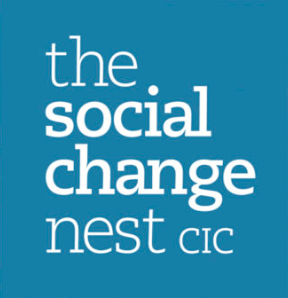Making “risky” business our business
Bridging the gap between funders and the needs of grassroots groups
In previous blogs we have talked about the need for grassroots movements vs. funder’s resistance to risk, and questioned the meaning of the word in this context. Next in our exploring risk in funding series, we wanted to look at the role that we, The Social Change Nest, play in all this. How do we make sure that we’re walking the walk as opposed to just talking the talk?
It is clear that there is a disconnect between how risk is perceived by funders and the reality of what it looks like for communities. The panellists from our Risky Business event have already said it better than I could, so I’ll pass the metaphorical mic over to them:
“Everyday people in communities are balancing bigger risks than you’ve ever considered” – Caroline Mawer, Camden Giving
“It’s absurd that funders are holding grassroots organisers to account when they are held to account by their own communities.” – Jo Wells, various social sector advisory roles
What came up when we surfaced this conversation was that there needs to be a change of mindset. Instead of asking ‘what is the risk of giving this money,’ funders need to be asking themselves, ‘what is the risk of not giving this money?’
As another of our panellists Nonhlanhla Makuyana (Decolonising Economics) said, “giving a little bit doesn’t create the sustainability needed to build strong movements that take us to the future we want to get to.” If we believe in funding grassroots groups, having seen the important role they play in social change, we need to be giving enough resources for them to not only survive, but thrive.
To get there, we need something to bridge the gap between where the funders are, and the needs of grassroots groups. This is where The Social Change Nest comes in. Our deep understanding of the two sides has allowed us to build frameworks and services to help navigate this disconnect. Acting as a kind of ‘social change scaffolding’, we aim to offer services that close the gap between funders and grassroots groups, whilst sharing the resources and advocating for longer-term systemic change.
In addition to holding spaces for discussion such as our Risky Business event, we are guiding funders through processes to enable a smooth transition to embracing risk. We also offer vital support to grassroots groups to enable them to build out the capacity needed so they are ready to thrive as they get the funding they so deserve.
social change is slow and takes time – well, less time if you fund the grassroots groups and movements at the forefront of social change
Supporting funders through this change process makes it an easier shift for them to fund grassroots organisations directly in the future – we are playing the long game here. After all, true social change is slow and takes time – well, less time if you fund the grassroots groups and movements at the forefront of social change…
Much like any kind of scaffolding, the end goal is for us to step away, take the temporary structure down, and find behind two well-connected metaphorical buildings – one representing the funders, and the other the communities they serve. In the meantime, we’ll be here talking to and guiding funders and empowering and strengthening community groups.
Grace Sodzi-Smith,
Partnerships Manager at The Social Change Nest
A solution enabling funders to fund movements, networks and changemakers
Don’t let bureaucracy become the oppressor. At the core of The Social Change Nest, is a desire to provide a solution which enables funders to be able to fund movements, networks and changemakers without adding to their problems.
All of the funders we work with see the value in community led change. They approach us wanting to find a way to send funding to grassroots groups that involves minimal administrative work for the groups and allows them to work with the funding in a way that suits them.
Funders come to us frustrated with their internal systems and we step in to lift this barrier
However, some of the funders we work with come to us in a position where their current way of distributing funds involves navigating a heavily bureaucratic system of getting funding signed off. The systems that a lot of funders work within limit the pace at which they can deliver funds to grassroots groups in the timelines that the groups need it. This then causes missed opportunities for grassroots groups to receive the funding at all which, you might say, defeats the point.
Funders come to us frustrated with their internal systems and we step in to lift this barrier. We do this in part, by providing the opportunity for groups to be fiscally hosted by us on the Open Collective platform, where they can see and manage their funding transparently and collaboratively.
Granting to grassroots groups inherently involves microgranting, which is more admin than managing bigger grants, and a lot of funders don’t (yet) have the infrastructure or the time to invest in building the systems to navigate it. We enable funders to distribute small grants at a quicker rate than big grants, which tend to happen once in a blue moon. This then means grassroots groups get to work continuously as opposed to waiting for ages to get started and so potentially losing out on taking on time-bound projects.
funding doesn’t have to involve a series of hierarchical hurdle jumps
Transparency, trust and communication is central to our process; we build relationships with both funders and groups so that everyone involved understands what our process is and can feel supported throughout. This helps to demystify the world of funding and receiving grants by both showing groups how they can manage their funding easily and transparently, and also showing funders that funding doesn’t have to involve a series of hierarchical hurdle jumps. Funding then emerges as something much more doable and in their control than both sides had originally thought.
In evaluating our impact, we found that 80% of funders* said working with The Social Change Nest has encouraged them to make deeper shifts to their funding policies or models. Lankelly Chase are one of these and have changed their policies through their board. Joe Doran reflected on this by stating “It’s been heartening, and heartbreakingly obvious, to see how changing the plumbing of funding (the ancient, fixed and hidden pipework that dictates flow and direction and was built by people removed from current realities) has allowed capital to be redistributed in different ways to different groups”.
It has demonstrated how out of touch, unfit for purpose and power hungry the philanthropic world
He goes on to say that “this is one of the great and enduring benefits of The Social Change Nest. The shadow side is that The Social Change Nest highlights how much of an irredeemable failure the current system is. It has demonstrated how out of touch, unfit for purpose and power hungry the philanthropic world is that it has to find workarounds to its own processes.”
Despite all of the work we are doing to try to alleviate the risk for funders and to bridge the disconnect in more specific ways, it is also important to remember that this is a temporary solution to an issue that is dynamic and what should be considered as part of examining how power and controls flows through ‘resource’ (money, time people) management. This is why creating spaces such as Risky Business are so important and highlights the ever-crucial need to continue to learn together.
*who responded to the survey
Becca Bolton,
Project Manager at The Social Change Nest
If you’re interested in learning more about getting funding to grassroots groups, email us at hello@thesocialchangenest.org.

At The Social Change Nest, we’re radically transforming the funding landscape. We nurture grassroots groups and enable funders to support frontline social action.
As a community interest company (CIC), we’re the non-profit sister to The Social Change Agency.
In 2022 we were honoured to have The Social Change Nest listed among the Top 100 Social Enterprises in the UK.
Our vision is to build a vibrant and thriving civil society where social change happens from the ground up and the power to create change is open to all.
originally published at The Social Change Agency
featured photo by Sammie Chaffin on Unsplash

Network Weaver is dedicated to offering free content to all – in support of equity, justice and transformation for all.
We appreciate your support!
Building Trust Through Grantee Feedback
A Conversation with Rohini Nilekani Philanthropies
In CEP’s recent publication, New Attitudes, Old Practices: The Provision of Multiyear General Operating Support, nearly all interviewed foundation leaders emphasized the importance of trust between funders and grantees. Moreover, CEP found that foundation leaders who provide more multiyear general operating support made an intentional choice to do so based on their belief that it will build trust, strengthen relationships, and increase impact.
When Rohini Nilekani Philanthropies (RNP), a foundation located in Bangalore, India, gathered feedback from its grantees through the Grantee Perception Report (GPR) in 2020, RNP was rated in the top 1 percent of CEP’s overall comparative dataset for perceptions of trust. Simultaneously, RNP grantees rated in the bottom 1 percent of the dataset for the amount of pressure they felt to modify their organization’s priorities in order to receive funding from the foundation.
How did RNP achieve this? To what practices does the foundation’s team adhere to build trust with grantees in their interactions? How do they think about trust-based philanthropy?
For answers to these questions, we recently talked to members of RNP’s leadership team: Founder-Chairperson Rohini Nilekani (who, with her husband Nandan Nilekani, has signed the Giving Pledge), Director of Strategy Gautam John, and Associate Director Natasha Joshi.
The team explains their approach in this new video:
Here are some more thoughts from Nilekani, John, and Joshi on several key elements of centering trust in their approach:
Starting with Trust is Important
Rohini Nilekani (RN): We’ve all been on the other side (of the funding table) and know how hard it is. Things change so quickly on the ground. We need to be agile and can’t be stuck with budget lines or line items that we have to stick to. Of course, you have to do due diligence, but if you don’t start off assuming the right intent and methodology on the other side, then what are you going to do? Then you must take over and do it yourself. When you’ve found the right leaders and institutions, you have to let them do what they believe in. Because passion and commitment are what drive this sector.
Just like you can’t tell Picasso to use a little less red or blue when you commission a painting from him, you can’t tell civil society organizations, “Okay fine, but just do it my way a little more.” It won’t work! Starting with trust, after basic due diligence, seems to me not just a moral but also a strategic imperative. We have to first try trust — always.
Gautam John (GJ): I’ve spent 10 years working as a grantee trying to raise money from foundations. And in my experience, you can’t co-create by saying, “Do it my way.” That’s not co-creation, that’s called convincing. Our goal is to create something together. Co-creation is difficult because it means letting go of some degree of control — and that’s hard to do.
The Need for Humility
RN: If you keep chasing attribution, you become your own chokepoint. In philanthropy, it’s more important to recognize contribution, rather than seeking attribution. I can’t see how you can achieve the philanthropic goal behind what you want to achieve by chasing attribution. You have to hold your goal close to heart and be willing to trust others. Nobody can go at it alone.
Honestly, none of us know how change really happens. We only have some theories about it. I try to walk back from too much certainty; to occupy the grey and occupy doubt; to think, “My ideas may not be right”; to not allow myself to say, “I am right”; to keep a mirror in front of myself. Yes, there may be occasions where your perspectives may be understood and absorbed. But if you insist on doing things your way, you’ll only get a service provider, not a partner. You’ll end up with a contractor or vendor relationship, rather than with a partner who you can walk with.
GJ: Philanthropists usually wake up in the morning saying, “We know all the answers,” when really, we should be waking up with questions. Because the idea of co-creation comes from being willing to let go of some amount of control and to act from a place of humility and curiosity. Humility is rare in the philanthropic sector. “We don’t always know — you do, and we might be able to learn something from you” is what we need more of.
More Long-term, Flexible, Unrestricted Funding
Natasha Joshi (NJ): Rohini Nilekani deliberately chose not to set up a registered foundation. We were afraid of creating too much bureaucracy because sometimes, too much bureaucracy can make it hard to be flexible and responsive in your giving.
GJ: High-quality civil society organizations deliver high-quality outcomes. You can’t have one without the other, so one needs to be willing to invest in their organizations, their people, and attract talent.
Strangely, many philanthropists don’t behave with their nonprofit partners the way they do in their businesses. How people see for-profit companies versus nonprofits can be very different; the very same person can have completely different views on how capital should be used. I legitimately struggle with this and I don’t know where it comes from. In India, perhaps, it’s because the idea of ‘service’ has a long and deep history. On the other hand, I hear philanthropists bemoaning the lack of talent in the civil society sector. But you can’t have it all without being willing to invest in organization building by committing to long-term, unrestricted funding.
RN: Some philanthropists are nervous about trusting civil society organizations. In India, at the onset of Independence, and 60 years later still, many civil society organizations were Marxist and left leaning. Businessmen, who are usually philanthropists because they are the ones with access to capital, are usually more market leaning. This creates a political ideology divide. As a result, philanthropists in India don’t even get into trust modus. Rather, they create their own independent implementation arms. This means that you don’t have to trust anybody. The question of trust can be bypassed because you can do it all by yourself.
Of course, when trust is broken, you can pull back and create more rules. There are things that we can do. But when you have a car accident, it also doesn’t mean you never get in the car again.
But like I said, in order for real social change to happen, nobody can go at it alone. One has to always try trust first.
About the author:
Charlotte Brugman is manager, assessment and advisory services, at CEP. If you’d like to learn more about understanding and improving your relationships with grantees, including through collecting grantee feedback via the Grantee Perception Report (GPR), contact Charlotte, who is based in Amsterdam and leads CEP’s work with global funders, at charlotteb[at]cep.org.
originally published at CEP.org
featured image found HERE
Appreciate Network Weaver's library of free offerings and resources?
Donate below or click here
thank you!
Funding networks: Answering the what, why, and how
Networks often require donor funding to undertake activities to achieve their visions and missions. But, as we so often hear in our work with networks, mobilizing and managing adequate funds pose a host of challenges, both for networks and their donors. And, given the paucity of existing research, the fundamental questions of what, why, and how donors fund networks are as yet broadly unanswered.
Collective Mind recently completed the first phase of a participatory research study that engages both networks and donors to better understand donor funding to networks. By shedding light on these key questions, the study seeks to improve donors’ funding approaches with networks and to inform networks’ fundraising strategies. The first phase of our study included collecting responses from both networks and donors to an initial survey and reviewing the limited related evidence base. Our findings from this phase – outlined below – will inform the next steps of the research.
The what, why, and how of donor funding to networks
Based on survey responses and our review of the literature, practical challenges seem widespread. While many networks receive project or programmatic funding, these types of funds are generally mismatched to networks’ needs. A focus on outputs limits the ability of networks to cover their core functions like serving and engaging members. Appropriately funding networks requires funding processes – for communication, dialogue, exchange, co-creation, and collaboration – not necessarily funding specific projects. Networks require funding for developing network infrastructure and shared resources, member facilitation, convenings, communications, measurement and learning, general operations, facilitation, research, and more. In general, networks typically need more general flexible support that covers staffing costs – but struggle to find it.
Other practical challenges arise as a result of the sometimes-amorphous organizational status and limited capacity that networks often have. Networks without legal status or a central governance or management mechanism may limit their options for funding. Channelling funds through intermediaries as an alternative brings other administrative challenges. Likewise, networks often lack the capacity for grant/proposal writing and reporting and may not be able to meet strict financial and administrative requirements or follow related procedures.
These practical challenges, while critical, can be viewed as manifestations of deeper disconnects – between what and how donors fund and what networks need based on what they’re capable of undertaking and achieving. These disconnects can be structural, for example, where donor strategy and operations set short-term funding cycles or limit the flexibility of funding types. They can also reflect a lack or misunderstanding of the nature of networks, how they function, and the specific kinds of value they’re capable of creating by facilitating and coordinating members towards defining shared goals and taking collective action.
Non-project-based types of investments in networks might not align with donor goals or their needs to see a direct return. Similarly, donors often struggle to understand how their funding can help to support network development and improvements. As noted elsewhere, even understanding what a network’s capacity may be as a baseline to build that capacity can seem daunting. Measuring a network’s health and determining its potential for sustainability likewise require custom frameworks and tools grounded in network expertise. Furthermore, the nature of networks and how they create change defines how we can describe their impacts and measure success. The nonlinear nature of the value creation of networks – for which progress is often intangible – creates challenges for identifying, tracking, and monitoring outcomes and impacts.
Critically, myriad complications arise about the role(s) that donors should play when investing in a network. Networks and donors struggle with the challenge of donor influence that shifts the priorities of the network, lessens ownership, or creates conflicts. It is often unclear how a donor can fund without biasing the structure and direction of a network (particularly for nascent networks), either intentionally (e.g. by demanding changes to obtain funding) or unintentionally. Donors may also underestimate the range of roles they can play not just as a funder but as a member or supporter in other ways (such as connecting the network to other resources, partners, etc.).
Answering the pressing questions
These key findings are the starting point for our next steps. They will shape the templates against which we co-develop case studies on both networks and donors about their funding to deepen our understanding of the interconnected issues and develop cross-comparative analysis. Through these next stages of the research, we hope to answer questions from the most practical, such as whether networks should register as legal entities to increase their funding options, to those of the highest order – as to whether the philanthropic funding model for networks needs to be recreated.

Kerstin Tebbe is the Founder of Collective Mind.
Kerstin has 18 years of experience supporting networks and multi-stakeholder collaboration. Her passion for networks was ignited by 6.5 years (2008-2014) spent on the Secretariat for the Inter-Agency Network for Education in Emergencies (INEE) where she coordinated an international technical working group, established a pan-African knowledge hub, and served as Deputy/Acting Director of the network.
Interested in participating in our research and developing a case study of your organization? Get in touch at kerstin@collectivemindglobal.org.
Originally published at alliancemagazine.org
featured image found HERE


